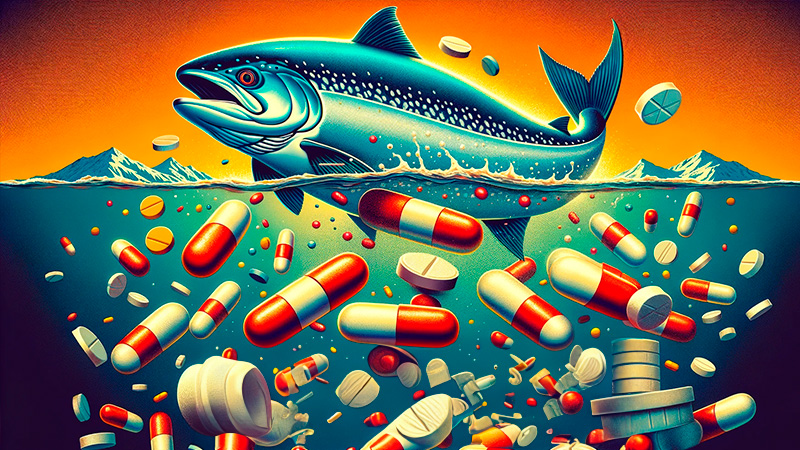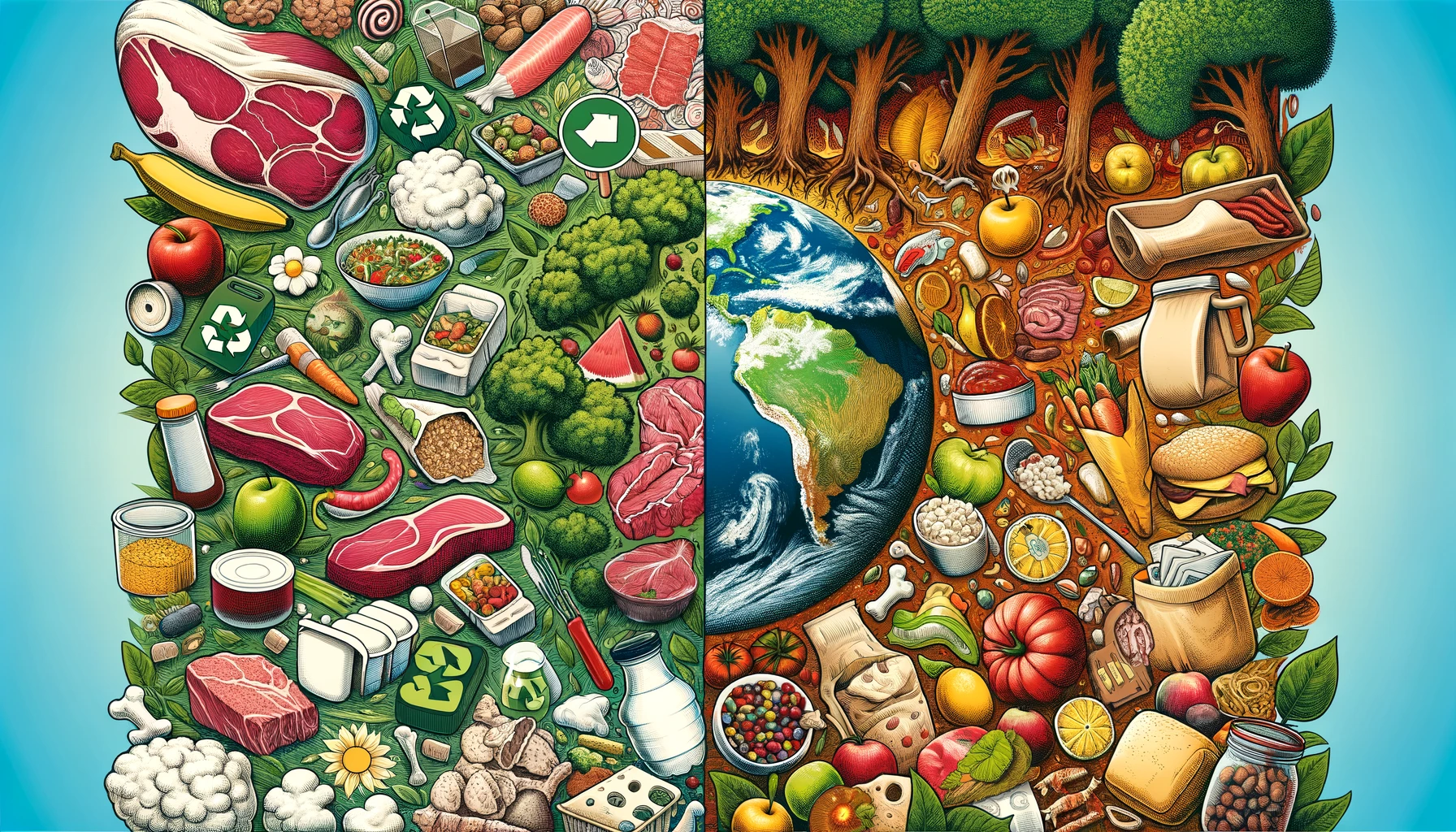Chilean farmed salmon is the most widely produced salmon in the world, but the shocking truth is that a large amount of antibiotics are used behind its production.
According to a study by the international marine conservation organization “Oceana,” the amount of antibiotics used in Chilean farmed salmon is approximately 5,600 times higher than in Norwegian salmon.
Specifically, Chilean salmon use 950 grams of antibiotics per ton, which is much more than the pork industry (172 grams per ton). 1
INDEX
Why are so many antibiotics used in Chilean salmon?
Chilean salmon farms use high-density rearing.
In other words, they grow a lot of salmon crammed into a small space.
In this environment, diseases are more likely to spread.
In addition, Chilean fish farms have complicated ocean currents and unstable sea water temperatures, which increases the incidence of disease.
Aquaculture operators prioritize cost reduction and use large doses of antibiotics to prevent disease.
In addition, some Chilean aquaculturists are taking advantage of the lack of adequate regulation of antibiotic use and are administering excessive doses of antibiotics.
This unregulated use of antibiotics increases the risk of outbreaks of resistant bacteria and environmental contamination.
The Chilean government is working to resolve this problem by strengthening regulations and establishing a monitoring system, but there is a need to raise awareness among aquaculture operators and implement effective measures.
Problems Caused by Massive Use of Antibiotics.
1. Outbreak of resistant bacteria
Continued use of antibiotics in large quantities can lead to the development of resistant bacteria that do not respond to the antibiotic.
This is a major problem in the human medical field.
The outbreak of resistant bacteria in aquaculture farms can affect us humans as well.
For example, there is a risk that antibiotic-resistant E. coli or streptococci could be released from aquaculture farms into the marine environment and ultimately infect humans.
2. Antibiotic residues.
Some of the antibiotics administered remain in the salmon.
When we eat that salmon, we are unknowingly ingesting antibiotics.
Long-term consumption of antibiotics may also increase the number of resistant bacteria in our bodies.
Furthermore, antibiotic residues can have negative effects on our health, such as causing allergic reactions and imbalances in our intestinal flora.
3. Environmental Impact
Antibiotics can be released into the environment along with wastewater and waste, potentially causing environmental contamination.
Antibiotics released from aquaculture farms into the marine environment can affect aquatic organisms and upset the balance of the ecosystem.
There is also concern that if antibiotics accumulate in the soil, they may inhibit the activity of soil microorganisms and adversely affect the growth of agricultural crops.
On the other hand, Japanese and Norwegian salmon use about one-tenth the amount of antibiotics as Chilean salmon, making them much safer.
The amount of antibiotics used in Japanese salmon is estimated to be about 100 grams per ton, and Norwegian salmon is about the same or less.
This is because the ocean currents and sea water temperatures are stable in Japanese and Norwegian farms, and the incidence of disease is low.
In Japan, laws and regulations governing the management of fish farms are in place, and the use of antibiotics is strictly limited.
In addition, many aquaculture companies have introduced farming methods that do not rely on antibiotics and focus on fish health management.
In Norway, farmers and the government have worked together since the 1980s to reduce the use of antibiotics.
As a result, antibiotic use in Norwegian salmon has dropped from 48 tons in 1987 to just 0.17 tons in 2020.2
Norwegian aquaculture companies have focused on the development and use of vaccines to successfully prevent disease.
They have also reduced disease outbreaks by improving farm conditions and reducing stress on the fish.
These efforts have led to a reduction in the use of antibiotics.
In addition, increased awareness and efforts by aquaculture operators have also led to a decrease in antibiotic use.
Japanese and Norwegian farmers are pursuing sustainable farming practices that do not rely on antibiotics, and are striving to produce safe, high-quality salmon to earn the trust of consumers.
The examples from Japan and Norway show that with proper management and technological innovation, it is possible to significantly reduce the use of antibiotics.
It is hoped that such efforts will spread to other aquaculture countries, including Chile.
Consumers can also support sustainable aquaculture and contribute to the reduction of antibiotic use by choosing safe domestic and Norwegian salmon.
Antibiotic-free salmon farming initiative
In Norway, efforts to minimize the use of antibiotics continue, thanks to successful efforts to improve aquaculture conditions and prevent disease outbreaks through the use of vaccines and other measures.
Local salmon are also being developed and produced in many parts of Japan.
These salmon are raised and fed in ways that take advantage of regional characteristics, and are popular for their low antibiotic use and safe, tasty salmon.
Typical local salmon in Japan include Sado Salmon (Sado Island, Niigata Prefecture), Strait Salmon (Aomori Prefecture), Oirase Salmon (Aomori Prefecture), Sanriku Salmon (Iwate Prefecture), Hida Salmon (Gifu Prefecture), and Naruto Salmon (Tokushima Prefecture).
Summary
The problem of Chilean farmed salmon being covered with antibiotics is a serious issue that directly affects our consumers’ health.
It is important to look at where the fish comes from and how it is farmed, rather than just looking for the cheapest price.
Choosing salmon imported from countries that minimize the use of antibiotics and use sustainable farming practices, as well as local salmon from within Japan, will help protect our health.
When buying salmon, we encourage you to pay attention to where it comes from and how it is farmed.
By making wise choices, you will contribute to a healthier and more sustainable diet.
Q&A
Q1: Is Chilean salmon the only type of salmon that uses a lot of antibiotics?
A1:In some cases, other than Chilean, farmed tuna and farmed yellowtail use higher amounts of antibiotics.
However, there are not as many cases where they are used in as large quantities as in salmon.
In recent years, antibiotic use in farmed fish has been declining due to increased awareness among farmers and stricter government regulations.
Q2: How can we reduce the use of antibiotics?
A2: Changes in farmer awareness and behavior, stricter government regulations, and the use of third-party certification programs are all important.
Consumers can support these efforts by choosing salmon with low antibiotic use.
Q3: Is domestic salmon safe?
A3:Most domestic salmon are considered safe due to low antibiotic use.
However, there are differences among farms, so we recommend checking the place of origin and farming methods.
Q4:Why is Norwegian salmon safe?
A4:Norwegian fish farms have stable ocean currents and sea water temperatures, which results in a low incidence of disease and reduced use of antibiotics.
Improved awareness and efforts by aquaculture operators have also led to a reduction in antibiotic use.
Q5: Is it safe to eat Chilean salmon?
A5:The amount of antibiotics contained in Chilean salmon is not considered to be at a level that would affect the human body.
However, there is a risk that long-term consumption may lead to an increase in resistant bacteria.
We recommend that you choose salmon with a high level of safety.
Q6: Which is safer, farmed or wild salmon?
A6:Both farmed and wild salmon are safe when properly managed.
However, natural salmon must be thoroughly cooked before eating because of the risk of parasites, etc. due to the ocean environment.
Farmed salmon, on the other hand, is a concern because of the amount of antibiotics used.
It is important to check the place of origin and farming method, and choose the safest one.



Comment